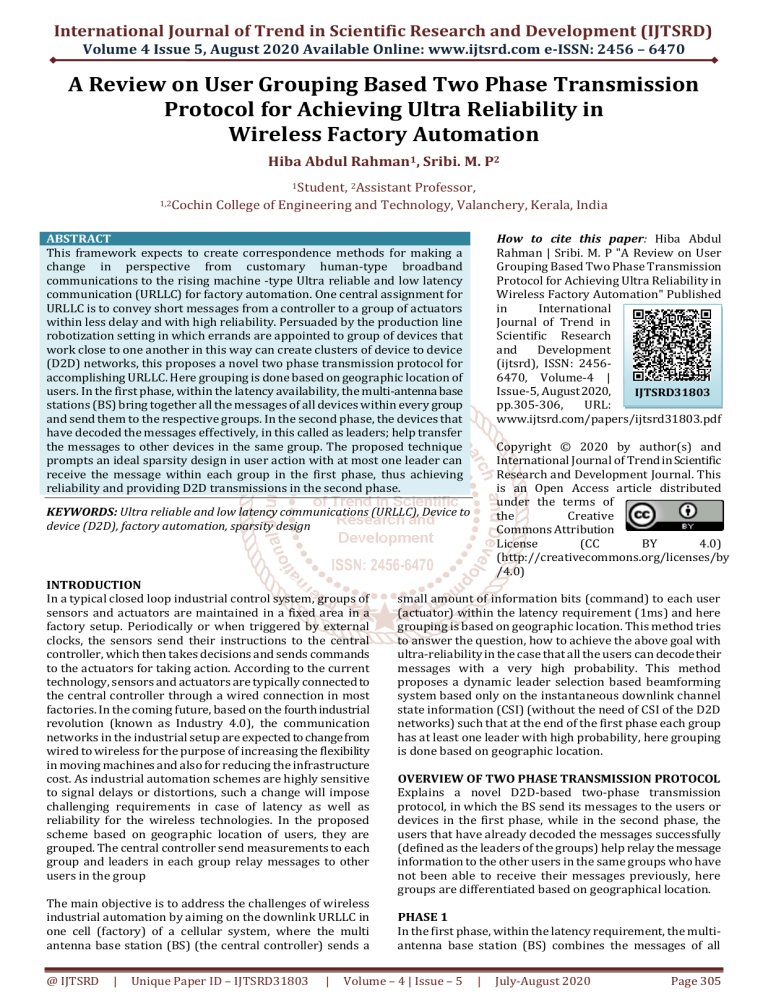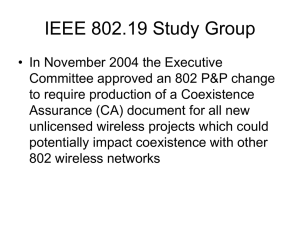
International Journal of Trend in Scientific Research and Development (IJTSRD)
Volume 4 Issue 5, August 2020 Available Online: www.ijtsrd.com e-ISSN: 2456 – 6470
A Review on User Grouping Based Two Phase Transmission
Protocol for Achieving Ultra Reliability in
Wireless Factory Automation
Hiba Abdul Rahman1, Sribi. M. P2
1Student, 2Assistant
1,2Cochin
Professor,
College of Engineering and Technology, Valanchery, Kerala, India
ABSTRACT
This framework expects to create correspondence methods for making a
change in perspective from customary human-type broadband
communications to the rising machine -type Ultra reliable and low latency
communication (URLLC) for factory automation. One central assignment for
URLLC is to convey short messages from a controller to a group of actuators
within less delay and with high reliability. Persuaded by the production line
robotization setting in which errands are appointed to group of devices that
work close to one another in this way can create clusters of device to device
(D2D) networks, this proposes a novel two phase transmission protocol for
accomplishing URLLC. Here grouping is done based on geographic location of
users. In the first phase, within the latency availability, the multi-antenna base
stations (BS) bring together all the messages of all devices within every group
and send them to the respective groups. In the second phase, the devices that
have decoded the messages effectively, in this called as leaders; help transfer
the messages to other devices in the same group. The proposed technique
prompts an ideal sparsity design in user action with at most one leader can
receive the message within each group in the first phase, thus achieving
reliability and providing D2D transmissions in the second phase.
How to cite this paper: Hiba Abdul
Rahman | Sribi. M. P "A Review on User
Grouping Based Two Phase Transmission
Protocol for Achieving Ultra Reliability in
Wireless Factory Automation" Published
in
International
Journal of Trend in
Scientific Research
and
Development
(ijtsrd), ISSN: 24566470, Volume-4 |
Issue-5, August 2020,
IJTSRD31803
pp.305-306,
URL:
www.ijtsrd.com/papers/ijtsrd31803.pdf
Copyright © 2020 by author(s) and
International Journal of Trend in Scientific
Research and Development Journal. This
is an Open Access article distributed
under the terms of
the
Creative
Commons Attribution
License
(CC
BY
4.0)
(http://creativecommons.org/licenses/by
/4.0)
KEYWORDS: Ultra reliable and low latency communications (URLLC), Device to
device (D2D), factory automation, sparsity design
INTRODUCTION
In a typical closed loop industrial control system, groups of
sensors and actuators are maintained in a fixed area in a
factory setup. Periodically or when triggered by external
clocks, the sensors send their instructions to the central
controller, which then takes decisions and sends commands
to the actuators for taking action. According to the current
technology, sensors and actuators are typically connected to
the central controller through a wired connection in most
factories. In the coming future, based on the fourth industrial
revolution (known as Industry 4.0), the communication
networks in the industrial setup are expected to change from
wired to wireless for the purpose of increasing the flexibility
in moving machines and also for reducing the infrastructure
cost. As industrial automation schemes are highly sensitive
to signal delays or distortions, such a change will impose
challenging requirements in case of latency as well as
reliability for the wireless technologies. In the proposed
scheme based on geographic location of users, they are
grouped. The central controller send measurements to each
group and leaders in each group relay messages to other
users in the group
The main objective is to address the challenges of wireless
industrial automation by aiming on the downlink URLLC in
one cell (factory) of a cellular system, where the multi
antenna base station (BS) (the central controller) sends a
@ IJTSRD
|
Unique Paper ID – IJTSRD31803
|
small amount of information bits (command) to each user
(actuator) within the latency requirement (1ms) and here
grouping is based on geographic location. This method tries
to answer the question, how to achieve the above goal with
ultra-reliability in the case that all the users can decode their
messages with a very high probability. This method
proposes a dynamic leader selection based beamforming
system based only on the instantaneous downlink channel
state information (CSI) (without the need of CSI of the D2D
networks) such that at the end of the first phase each group
has at least one leader with high probability, here grouping
is done based on geographic location.
OVERVIEW OF TWO PHASE TRANSMISSION PROTOCOL
Explains a novel D2D-based two-phase transmission
protocol, in which the BS send its messages to the users or
devices in the first phase, while in the second phase, the
users that have already decoded the messages successfully
(defined as the leaders of the groups) help relay the message
information to the other users in the same groups who have
not been able to receive their messages previously, here
groups are differentiated based on geographical location.
PHASE 1
In the first phase, within the latency requirement, the multiantenna base station (BS) combines the messages of all
Volume – 4 | Issue – 5
|
July-August 2020
Page 305
International Journal of Trend in Scientific Research and Development (IJTSRD) @ www.ijtsrd.com eISSN: 2456-6470
devices within each group together and multicasts these
messages to the respective groups; messages for distinguish
groups are spatially multiplexed, here grouping of devices is
done based on geographic location of devices.
PHASE 2
In the second phase, the devices that have decoded the
messages successfully, herein called as the leaders, help
relay the messages to all other devices in their groups. Under
the proposed protocol, an innovative leader selection based
beam forming method at the BS by utilizing sparse
optimization technique. Thus all the devices in the group
receives the message successfully.
CONCLUSION
We have presented a d2d-based two phase transmission
protocol for ultra-reliable wireless communications for
factory automation purpose. Explains about a novel two
phase transmission protocol for achieving URLLC. Under this
protocol, each group’s messages are combined together and
multicast to the leaders i.e., users that have already decoded
the message from the BS in the first phase, while the leaders
send the messages to the other users in the groups in the
phase II. Due to the strong channels between the users in the
same group D2D network is reliable, the challenge of our
protocol is to select at least one leader for each group in the
phase I through a proper beamforming design at the BS.
REFERENCES
[1] Liang Liu and Wei Yu, “A D2D-based Protocol for UltraReliable Wireless Communications for Industrial
Automation”, 2018 IEEE
[2] E. Karipidis, N. D. Sidiropoulos, and Z. Q. Luo, “Quality
of service and max-min fair transmit beamforming to
multiple cochannel multicast groups,” IEEE Trans.
Signal Process., vol. 56, no. 8, pp. 1268-1279, Mar.
2008.
[3] J. Liu, N. Kato, J. Ma, and N. Kadowaki, “Device-to-device
communication in LTE-advanced networks: A survey,”
IEEE Commun. Surveys Tuts., vol. 17, no. 4, pp. 19231940, 4th Quart., 2015.
[4] P. Popovski, “Ultra-reliable communication in 5G
wireless systems,” in Proc. IEEE Int. Conf. 5G for
Ubiquitous Connectivity (5GU), Nov. 2014, pp. 146151.
@ IJTSRD
|
Unique Paper ID – IJTSRD31803
|
[5] G. Durisi, T. Koch, and P. Popovski, “Toward massive,
ultrareliable, and low-latency wireless communication
with short packets,” Proc. IEEE, vol. 104, no. 9, pp.
1711-1726, Sep. 2016.
[6] N. A. Johansson, Y.-P. E. Wang, E. Eriksson, and M.
Hessler, “Radio access for ultra-reliable and lowlatency 5G communications,” in Proc. IEEE Int. Conf.
Commun. (ICC), London, UK., Jun. 2015, pp. 1184-1189.
[7] H. Shariatmadari, S. Iraji, and R. Jantti, “Analysis of
transmission
methods
for
ultra-reliable
communications,” in Proc. IEEE Pers. Indoor and
Mobile Radio Commun. (PIMRC), 2015, Hong Kong,
China, pp. 1126-1131.
[8] D. Ohmann, M. Simsek, and G. Fettweis, “Achieving high
availability in wireless networks by an optimal number
of Rayleigh-fading links,” in Proc. IEEE Globecom
Workshops, Dec. 2014, Austin, USA, pp.
[9] N. Brahmi, O. N. C. Yilmaz, K.W. Helmersson, S. A.
Ashraf, J. Torsner, “Deployment strategies for ultrareliable and low-latency communication in factory
automation,” in Proc. IEEE Globecom Workshops, San
Diego, USA, Dec. 2015.
[10] H. Shariatmadari, Z. Li, M. A. Uusitalo, S. Iraji, and R.
J¨antti, “Link adaptation design for ultra-reliable
communications,” in Proc. IEEE Int. Conf. Commun.
(ICC), Kuala Lumpur, Malaysia, 2016.
[11] O. N. C. Yilmaz, Y.-P. E. Wang, N. A. Johansson, N.
Brahmi, S. A. Ashraf, and J. Sachs, “Analysis of ultrareliable and low-latency 5G communication for a
factory automation use case,” in Proc. IEEE Int. Conf.
Commun. (ICC) Workshop, London, UK., Jun. 2015, pp.
1190-1195.
[12] V. N. Swamy et al., “Real-time cooperative
communication for automation over wireless,” IEEE
Trans. Wireless Commun., vol. 16, no. 11, pp. 71687183, Nov 2017.
[13] I. Mitliagkas, N. D. Sidiropoulos, and A. Swami, “Joint
power and admission control for ad-hoc and cognitive
underlay networks: Convex approximation and
distributed implementation,” IEEE Trans. Wireless
Commun., vol. 10, no. 12, pp. 4110-4121, Dec. 2011.
Volume – 4 | Issue – 5
|
July-August 2020
Page 306




